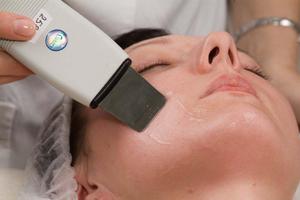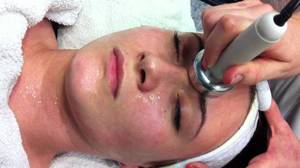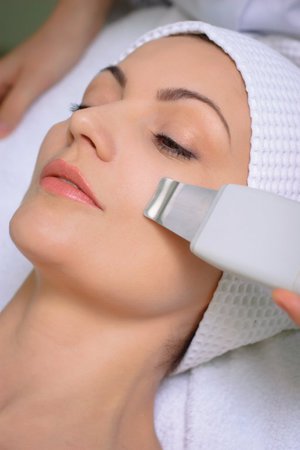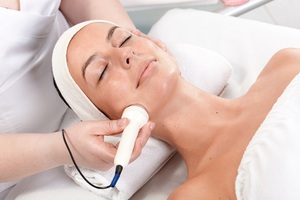Some methods of rejuvenation came to cosmetology from medicine, one of these procedures is ultrasonic phonophoresis. In physiotherapy, phonophoresis is used to treat diseases of the musculoskeletal system, internal organs, and skin diseases. Cosmetologists successfully apply the technique to combat stretch marks, cellulite, age-related skin aging.
Procedure action
To conduct ultrasonic phonophoresis in cosmetology, a special apparatus is used – it emits ultrasonic waves, which force cosmetic and medicinal substances to penetrate deep into the skin. The rejuvenating effect of ultraphonophoresis develops under the influence of chemical and physical factors. A medicinal substance acts as a chemical factor, a physical factor – ultrasound – causes vibration of the subcutaneous tissues.
Due to the combination of these two elements, after phonophoresis, the following effects develop:
-
Increases local blood circulation, improves the penetration of drugs into cells. As a result, tissues receive additional nutrition and hydration.
-
Regeneration processes start.
-
Stimulates the synthesis of collagen and elastin.
-
Increases local immunity.
-
Improves lymphatic drainage.
-
Inflammatory processes are eliminated.
-
Spasm of mimic muscles is eliminated.
-
Scars dissolve.
-
The therapeutic effect of the administered drug lasts for several days.
-
Headaches disappear.
Cosmetologists compare the effect of ultraphonophoresis on the skin of the face with lifting procedures: after completing a course of 7-14 sessions, the condition of the skin changes for the better. Already after the third session of phonophoresis, women notice an increase in the elasticity of the skin, the elimination of excess greasiness, and the smoothing of fine wrinkles. With regular procedures with certain drugs, complete resorption of scars can be achieved, in severe cases, scars soften and become less noticeable.
Indications and contraindications
Ultrasonic phonophoresis in cosmetology is most often used for facial skin rejuvenation, solving various cosmetic problems. Indications for the procedure on the face are:
-
![The use of ultrasonic phonophoresis of the face in cosmetology]()
Incorrect work of the sebaceous glands, which leads to excessive dryness or oily skin.
-
inflammatory phenomena.
-
Acne.
-
Flabbiness, age-related aging of the skin.
-
Puffiness.
-
Violation of blood circulation and lymph flow.
-
Shallow wrinkles.
It is forbidden to perform ultrasound procedures on patients under such conditions:
-
![The use of ultrasonic phonophoresis of the face in cosmetology]()
Pregnancy.
-
Exacerbation of acne.
-
Diseases of the heart and blood vessels.
-
Epilepsy.
-
Acute infectious diseases.
-
Recent chemical or mechanical peeling.
-
Implants in the treatment area.
-
Arterial hypertension.
-
Fungal and viral diseases of the skin.
-
Moles.
-
Acute sinusitis or sinusitis.
Methodology
Ultrasonic phonophoresis is easy to carry out. The steps of the procedure are:
-
![The use of ultrasonic phonophoresis of the face in cosmetology]()
Facial cleansing with cosmetics.
-
Treatment with an antiseptic (chlorhexidine solution is usually used).
-
Applying a cosmetic or medical composition to the face.
-
ultrasonic impact. The tip of the device is moved over the surface of the skin, about 20 seconds are spent on each area of the face.
-
The face is wiped with an antiseptic, wiped dry, and a moisturizer is applied.
A phonophoresis session is carried out daily, after 7-14 sessions a break is taken for 3-5 months.
Required drugs
For the procedure, the following drugs are used:
-
![The use of ultrasonic phonophoresis of the face in cosmetology]()
Hyaluronic acid – improves the elasticity of the skin, moisturizes and nourishes the epidermis.
-
Vitamins A, E – are natural antioxidants, take part in metabolic processes, prevent cell aging.
-
Hydrocortisone is a medicinal substance from the group of glucocorticoids, it is used to treat inflammation on the skin of the face.
-
Lidaza is a drug that promotes the resorption of scars and scars.
-
Karipain, trypsin – also improve the processes of regeneration and resorption of adhesions and scars.
-
Antibiotic solutions – used to treat acne.
-
An aqueous solution of aloe is a natural biostimulant that starts rejuvenation processes in cells.
-
Ready-made solutions for phonophoresis in ampoules – they can be purchased at pharmacies and specialized stores. The composition of the solutions includes extracts of medicinal plants, collagen and elastin, chitosan, placenta extract, royal jelly. The action of ampoules is aimed at restoring cellular functions that have been disturbed under the influence of external or internal factors and have led to a deterioration in the skin condition.
At home
Ultrasonic phonophoresis can be performed at home using an ultrasonic scrubber – the device is used for ultrasonic facial cleansing. Some models of scrubbers are equipped with a nozzle for phonophoresis and micromassage, but the minus of the home procedure is the low power of the devices. Therefore, to obtain a noticeable and stable cosmetic result, it is recommended to carry out ultraphonophoresis in a beauty salon.
Phonophoresis in cosmetology is a popular procedure, since the positive result of its use has been confirmed by many specialists.





